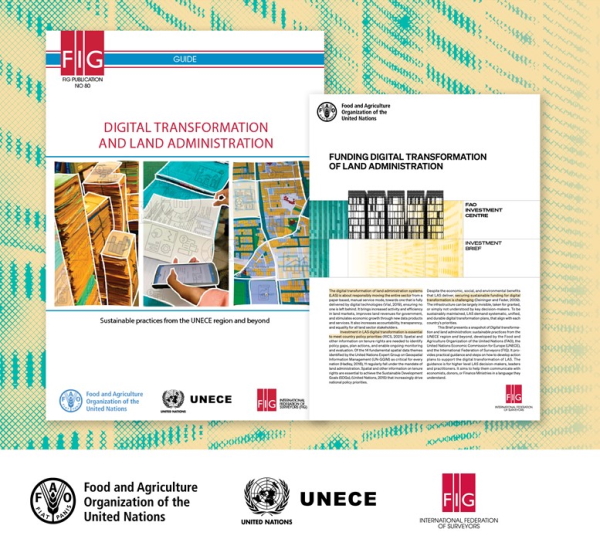

News in 2022
|

Land administration systems are increasingly becoming digitized, making applying for a mortgage, say, or registering a new building or property deed easier.
When done responsibly, the digital transformation of land administration systems carries many benefits.
It can increase activity and efficiency in land markets, improve land revenues for governments and stimulate economic growth through new data products and services.
It can also increase accountability, transparency and equality for all land sector stakeholders. Yet securing sustainable funding for the digital transformation is still a challenge.
Funding digital transformation of land administration is a new FAO investment brief. It summarizes the main findings of a soon to launch e-book titled Digital Transformation and Land Administration: Sustainable Practices from the UNECE Region and Beyond. The latter was the product of a fruitful collaboration between FAO, the United Nations Economic Commission for Europe (UNECE) and its Working Party for Land Administration (WPLA), and the International Federation of Surveyors (FIG).
The investment brief provides practical guidance and steps on how to develop action plans to support the sustainable digital transformation of land administration systems.
Rumyana Tonchovska, Senior FAO Land Administration Officer, explained that “spatial and other information on tenure rights, in alignment with wider governmental polices and broader societal goals, is needed to identify policy gaps and plan actions to deal with countries’ most pressing issues.”
Those issues include everything from reducing poverty, enhancing climate change adaptation and mitigation and promoting clean energy policies to improving food security and creating more sustainable cities and rural environments, among others.
“That information also enables ongoing monitoring and evaluation and is essential for meeting the Sustainable Development Goals,” she added, noting that the brief is designed to help higher-level land administration decision-makers, leaders and practitioners communicate effectively with economists, donors and finance ministers.
Digital disruption is becoming the new normal. Embracing this disruption in land administration systems is an opportunity for operational improvements and strategic advancement.
The e-book Digital Transformation and Land Administration was inspired by land administration experiences across the globe during the COVID-19 pandemic. It shows that land administration systems coped – and often thrived – during lockdowns. This was largely thanks to their digital transformation, which makes the case for upscaling the digital transformation of land administration systems all the more urgent.
Digitized systems can reduce the cost of essential services or make them free. In Bulgaria, Croatia, Serbia, Bosnia and Herzegovina, Moldova and other countries, for example, citizens can run limited free online checks on the status of their property. This helps remove travel, paper documents and long queues at government offices.
Land administration systems are also becoming more intelligent, interoperable, inclusive, interactive, incorporated and invested in. They respond to diverse local drivers and complex megatrends. This includes demographic changes, increasing societal disparities, economic volatility, newly emerging business ecosystems, anthropogenic environmental damage, decentralized operating environments, political power shifts and rapid urbanization.
As with all digital disruption, it is essential to ensure that no one is left behind – and that the digital divide does not widen.
The investment brief points out that land administration system organizations without an action plan for digital transformation must create one. Those whose systems are already on a digital path, should re-evaluate current plans and seek opportunities for acceleration.
In the short term, these organizations should establish a cross-sector committee, adopt the disruption paradigm, develop action plans and encourage global and regional engagement.
In the medium term, actions should focus on adopting a plan, sourcing investment and implementation.
Clear goal setting, indicators, underlying data analytics, cybersecurity measures and IT upskilling can help manage risks and sustain the performance of the systems.
Louise Friis-Hansen, FIG Director, pointed out that context matters.
“There is no ‘one size fits all approach’ for the digital transformation
of land administration systems,” she said. “Solutions need to be
tailored to local contexts, needs and drivers, but there are valuable
lessons to be learned from different experiences, regionally and
nationally, which should be shared.”
October 2022